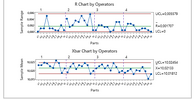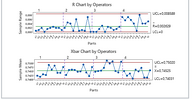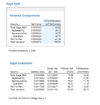P
Periannan
Dear Guys,
Kindly need your help on interpret the graphical result of GR&R. Base on the attached file, what I can observed is
1. The study was done base on part tolerance instead of total variation. Believe there is a reason behind such the customer would like to see whether the process control is able to meet the part tolerance and suitability of gage for product acceptance to the specification. As a end result the study show pretty fine
2. The GR&R value that calculate in total variation is seem to be over than 30%. By right the study should fail. Seems the interest is in different view, somehow it is accepted.
3. The impact will be seeing in NDC, the value will be lower than 5 due to GR&R value is over than 30% (calculate in TV) – Correct me if my understanding is wrong
4. R Chart by operator – I can’t really explain about the graph as no idea on it. As far as I know the point should not fall out side the control limit. Believe you guys can help me to understand the purpose of this graph.
5. X Bar Chart By operator – it seems most of the point is fall outside the control limits, this show the variation is due to difference between part instead of measuring system. However fixing operator misnan and zurin can show much more good result.
6. Data by part number – show the variation between parts, the white dot show the different value (range) is seeing for each trial. We also can conclude the part problem as question why a certain part shows different reading for most of the trial (range). Correct me if my understanding is wrong
7. Data By operator – Show the operator variation in term of reproducibility. A straight line a cross the appraisal shows the good reproducibility.
8. Operator part interaction – indicating the significant interaction between each Part and Operator. I can’t really understand as what the graphs try to deliver in stead of interaction. It is related to reproducibility?
Periannan
Kindly need your help on interpret the graphical result of GR&R. Base on the attached file, what I can observed is
1. The study was done base on part tolerance instead of total variation. Believe there is a reason behind such the customer would like to see whether the process control is able to meet the part tolerance and suitability of gage for product acceptance to the specification. As a end result the study show pretty fine
2. The GR&R value that calculate in total variation is seem to be over than 30%. By right the study should fail. Seems the interest is in different view, somehow it is accepted.
3. The impact will be seeing in NDC, the value will be lower than 5 due to GR&R value is over than 30% (calculate in TV) – Correct me if my understanding is wrong
4. R Chart by operator – I can’t really explain about the graph as no idea on it. As far as I know the point should not fall out side the control limit. Believe you guys can help me to understand the purpose of this graph.
5. X Bar Chart By operator – it seems most of the point is fall outside the control limits, this show the variation is due to difference between part instead of measuring system. However fixing operator misnan and zurin can show much more good result.
6. Data by part number – show the variation between parts, the white dot show the different value (range) is seeing for each trial. We also can conclude the part problem as question why a certain part shows different reading for most of the trial (range). Correct me if my understanding is wrong
7. Data By operator – Show the operator variation in term of reproducibility. A straight line a cross the appraisal shows the good reproducibility.
8. Operator part interaction – indicating the significant interaction between each Part and Operator. I can’t really understand as what the graphs try to deliver in stead of interaction. It is related to reproducibility?
Periannan






